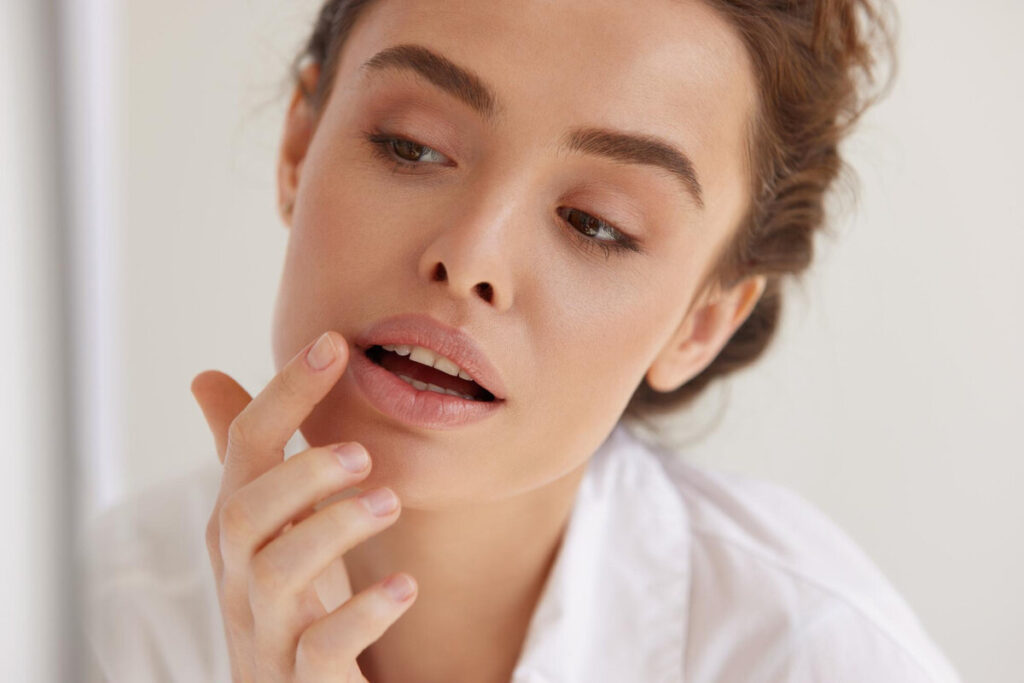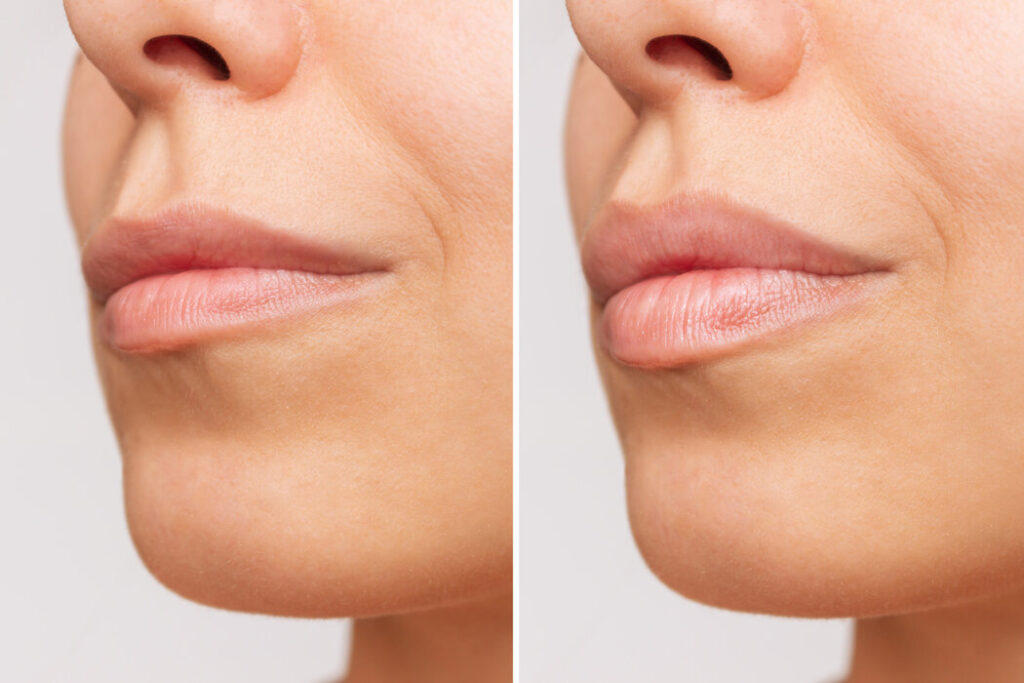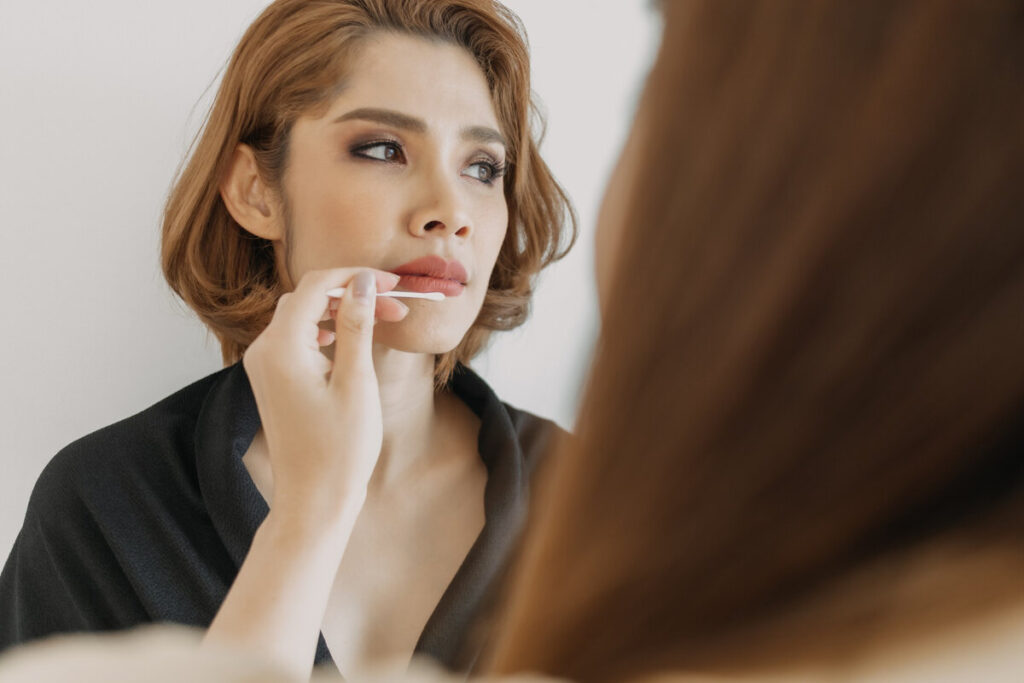The moment your aesthetic treatment concludes marks the beginning of your body’s intricate healing journey. Lip filler aftercare doesn’t merely influence your results—it fundamentally determines them. Those initial 72 hours following injection establish the foundation for how your fillers integrate with your tissues, affecting everything from symmetry to longevity.
Many people wrongly think that the specialist’s skill determines their outcome, ignoring how their own post-procedural decisions affect the final aesthetic. The reality? When appropriate healing techniques are not followed, even perfectly placed fillers can migrate, break down early, or cause difficulties.
Swelling naturally peaks around 24-48 hours post-procedure, often creating temporary asymmetry that resolves gradually. This timing presents the first crucial window where your actions directly impact healing trajectories. Lip filler recovery goes beyond simple discomfort management by including an estimated method of reducing inflammatory reactions and optimizing filler stability.
Your lips’ vascular nature makes them more sensitive to both positive and negative effects during recovery. This increased responsiveness helps to explain why your results might clearly be affected by seemingly minor factors—from salt intake to sleeping position—can visibly affect your results. Understanding these connections transforms routine aftercare from a list of restrictions into a purposeful strategy for aesthetic optimization.
Those seeking subtle enhancement often express concern about looking “obviously done” during recovery. Following evidence-based post lip filler care guidelines accelerates the transition from post-procedure swelling to natural-looking integration, allowing you to enjoy your refreshed appearance sooner without drawing unwanted attention to recent treatment.
The investment in professional lip enhancement deserves protection through informed recovery practices. This comprehensive guide distills essential aftercare strategies to safeguard your results while minimizing downtime—ensuring your enhancement journey delivers the refined, long-lasting results you envision.
Avoid Touching or Rubbing Your Lips
Why You Shouldn’t Touch Your Enhanced Lips
The temptation to explore newly enhanced lips through touch proves nearly universal among patients. Yet this seemingly innocent impulse ranks among the most detrimental actions during early lip filler aftercare. Why does this matter so profoundly? Freshly injected filler remains malleable for approximately two weeks before fully integrating with surrounding tissues.
During this vulnerability window, even gentle pressure can displace filler from intended positions, potentially creating lumps, asymmetry, or migration beyond lip borders. These positioning shifts often require corrective treatments that could have been entirely avoided through a hands-off approach.
Beyond displacement concerns lies an equally significant risk: bacterial introduction. Injection sites create microscopic entry points where the skin’s protective barrier has been compromised. Your fingertips, regardless of perceived cleanliness, harbor microorganisms that can trigger infection when transferred to these vulnerable areas. Such complications not only compromise aesthetic outcomes but may necessitate antibiotic intervention or premature filler dissolution.
Activities to Avoid After Treatment
What not to do after lip fillers extends beyond conscious touching to seemingly unrelated habits:
- Drinking through straws (creates negative pressure affecting filler positioning)
- Playing wind instruments
- Whistling
- Exaggerated facial expressions during animated conversations
- Applying makeup directly to the lips
- Aggressive teeth brushing that contacts the lip borders
- Sleeping face-down
Cosmetic products introduce additional variables best avoided initially. Lipsticks, plumping glosses, and even some balms contain ingredients potentially irritating to healing tissues. Moreover, their application typically involves direct contact and pressure—precisely what healing lips need to avoid.
HS MedSpa practitioners recommend waiting a minimum 24 hours before introducing even the gentlest products to your enhanced lips.
When discomfort or dryness arises—as it commonly does—resist addressing these sensations through manipulation. Instead, carefully apply practitioner-approved hydrating products using clean cotton swabs rather than fingertips, minimizing both contamination risk and displacement pressure.
Remember that initial asymmetry rarely indicates problematic injection technique but rather reflects normal inflammatory responses that resolve differently across various lip regions. Document any concerns photographically rather than attempting to “correct” perceived unevenness through pressure or manipulation.

Stay Away from Heat and Sun Exposure
How Heat Affects Your Results
The days following your enhancement procedure require strategic environmental management for optimal healing. Heat and UV exposure—whether from natural or artificial sources—directly impact how your body processes and integrates dermal fillers. Understanding these influences helps you make informed choices during the crucial early days after lip injections.
Heat exposure triggers vasodilation—the widening of blood vessels—which intensifies swelling beyond levels your body would naturally produce during healing. This excessive inflammation not only prolongs your recovery timeline but potentially impacts filler placement during the critical settling phase. Moreover, heat accelerates metabolic processes that can prematurely degrade filler materials, potentially shortening your results’ longevity.
Heat Sources to Avoid
Sources requiring careful avoidance include:
- Saunas, steam rooms, and hot tubs
- Hot showers directed at the face
- Heated styling tools used near the mouth area
- Hot beverages and foods that release steam directly onto lips
- Intense cardio exercise that raises body temperature significantly
- Direct sunlight exposure, especially during peak hours
Exercise Considerations
The question “Can you work out after lip filler?” frequently arises among active patients. Cardiovascular exercise dramatically increases body temperature and blood flow—both counterproductive to minimizing swelling. Most practitioners recommend postponing moderate exercise for at least 24 hours and intense workouts for 72+ hours following treatment. When resuming activity, choose cooler environments and consider temporarily reducing intensity to minimize facial flushing.
Sun Protection Strategies
Solar exposure introduces additional complications through UV radiation, which penetrates skin to trigger inflammatory responses and accelerate hyaluronic acid breakdown. Even brief sun exposure during initial healing can create uneven pigmentation at injection sites. This vulnerability explains why postponing beach vacations, outdoor sporting events, or extended sun exposure for two weeks post-procedure significantly benefits your results.
Practical protection strategies during unavoidable exposure include:
- Wide-brimmed hats that cast facial shade
- Mineral-based SPF 30+ lip products (once initial healing permits)
- Seeking shade consistently
- Scheduling outdoor activities during lower UV index hours
- Using umbrellas for additional shade
- Wearing UV-protective clothing
Temperature extremes in either direction warrant consideration. While cooling measures like gentle cold compresses can offer comfort and swelling reduction during initial recovery, excessive cold may temporarily constrict blood vessels, potentially affecting filler integration. Balance rather than extremes guides optimal healing.
Dermal fillers respond differently to environmental factors depending on their specific composition. Your practitioner’s aftercare instructions may include personalized modifications based on the particular product used in your treatment. Following these specialized recommendations optimizes your specific filler’s performance characteristics.
Hydration and Skin Care
Hydration: The Foundation of Optimal Results
The foundation of successful lip filler recovery begins from within. Hyaluronic acid—the primary component in most modern lip fillers—functions through its remarkable ability to attract and bind water molecules. This hydrophilic property explains why proper hydration dramatically influences your enhancement’s fullness, natural appearance, and longevity.
Increasing water consumption for several days post-procedure provides the essential molecules your filler needs for optimal performance. This internal hydration strategy offers dual benefits: it maximizes volumizing effects while simultaneously supporting your body’s natural healing mechanisms by improving circulation and flushing inflammatory byproducts more efficiently from the treatment area.
Dietary Considerations
Patients frequently ask “can you eat after lip filler” without realizing how dietary choices impact their results. While eating is certainly permitted, strategic food selection during early recovery can meaningfully influence swelling patterns. Consider these evidence-based nutritional approaches:
- Limiting sodium intake to reduce water retention and excessive swelling
- Incorporating pineapple (contains bromelain) and other anti-inflammatory foods
- Choosing foods requiring minimal lip stretching or manipulation during consumption
- Avoiding extremely hot foods that increase blood flow to the lips
- Including antioxidant-rich foods that support healing
- Ensuring adequate protein intake for tissue repair
- Incorporating omega-3 fatty acids for their anti-inflammatory properties
External Hydration and Product Selection
External hydration requires equally thoughtful consideration. The day after lip injections often reveals increased surface dryness as your body navigates the healing process. While touching should remain minimal, gentle application of approved moisturizing products becomes increasingly important as initial healing progresses.
Select products free from potential irritants such as:
- Fragrances and essential oils
- Exfoliating acids (glycolic, salicylic, lactic)
- Retinoids and vitamin C
- Alcohol-based formulations
- Strong active ingredients
- Medicated lip products
- Products containing menthol, camphor, or cinnamon
Treatment-Specific Considerations
Understanding the distinction between Lip Flip vs Filler treatments helps clarify why aftercare requirements differ somewhat between these enhancement approaches. While fillers physically add volume through injected hyaluronic acid, lip flips use small amounts of neurotoxin to relax the muscle above the lip, causing it to roll slightly outward for a subtly enhanced appearance. Both require hydration, but fillers specifically depend on moisture molecules for their volumizing properties, making adequate hydration particularly crucial for this enhancement method.
Your regular skincare routine likely requires temporary modification during recovery. Products containing potentially irritating active ingredients should avoid the lip area until complete healing occurs (typically 10-14 days). Instead, prioritize gentle, hydrating formulations that support barrier restoration without introducing potential irritants to sensitized tissue.
When cleansing your face during early recovery, avoid direct contact or pressure on the lip area. Patting rather than rubbing when drying further minimizes disruption to healing tissues and filler positioning. These seemingly minor adjustments yield significant benefits for both comfort and aesthetic outcomes.

When to See Your Practitioner
Distinguishing Normal from Concerning Symptoms
While most enhancement journeys progress without significant complications, distinguishing between normal healing responses and concerning developments ensures both safety and optimal results. Certain symptoms warrant prompt communication with your provider rather than continued home management during lip filler recovery.
Normal post-procedure experiences typically include moderate swelling (peaking around 24-48 hours), potential bruising, temporary asymmetry, and mild tenderness at injection sites. These expected responses generally resolve progressively without intervention over 7-14 days.
Red Flags Requiring Professional Attention
Signs requiring professional evaluation include:
- Pain patterns: Discomfort that intensifies rather than gradually improving after 48 hours may indicate complications beyond normal inflammatory responses. While some tenderness is expected, pain described as severe, throbbing, or accompanied by significant warmth suggests possible infection requiring assessment.
- Visual changes: Dramatic color alterations in lip tissue demand immediate attention. Blanching (whitening), significant bluish discoloration, or a mottled appearance resembling marble patterns could indicate vascular compromise—a rare but serious complication requiring emergency intervention. Similarly, rapidly developing or asymmetric swelling that continues worsening beyond the expected 48-hour peak warrants prompt evaluation.
- Texture abnormalities: The development of delayed nodules or persistent lumps beyond two weeks post-procedure may indicate granuloma formation or other inflammatory reactions requiring professional management. These differ from immediate post-injection texture irregularities, which often resolve spontaneously during the settling period.
- Functional changes: Difficulty speaking, unusual numbness extending beyond the treatment area, or changes in your smile symmetry that persist beyond initial swelling should trigger practitioner consultation to rule out potential nerve involvement.
Communication and Follow-up Importance
Your lip filler treatment should include clear communication channels for addressing post-procedure concerns. Reputable providers maintain accessibility for questions arising during recovery, recognizing that prompt response to complications directly influences both safety outcomes and patient satisfaction.
Document your healing progression through dated photographs in consistent lighting and angles. These visual records provide valuable reference points for both you and your practitioner when discussing recovery concerns or potential complications. Images become particularly valuable when subtle changes occur gradually rather than appearing suddenly.
The Value of Scheduled Check-ins
Follow-up appointments aren’t merely formalities—they provide critical opportunities for professional assessment of your results once initial swelling has resolved. These visits allow practitioners to address subtle asymmetries or irregularities through minor adjustments while the filler remains most responsive to modification.
Remember that properly administered hyaluronic acid fillers can be modified or dissolved if necessary—an important safety feature distinguishing them from permanent enhancement options. This reversibility reinforces the importance of maintaining communication with your provider throughout your post-lip filler care journey.
The investment in professional enhancement deserves protection through attentive monitoring and appropriate intervention when needed. By understanding these important distinctions between normal healing and potential complications, you actively participate in safeguarding both your health and your aesthetic results.

Text to Coloring
March 27, 2025 at 8:16 pm
This is such an important reminder that aftercare plays just as big a role in results as the treatment itself! The point about how small factors like salt intake and sleeping position can impact healing was especially eye-opening. It’s great to see a focus on proactive recovery instead of just reacting to swelling—makes all the difference in getting the best outcome!